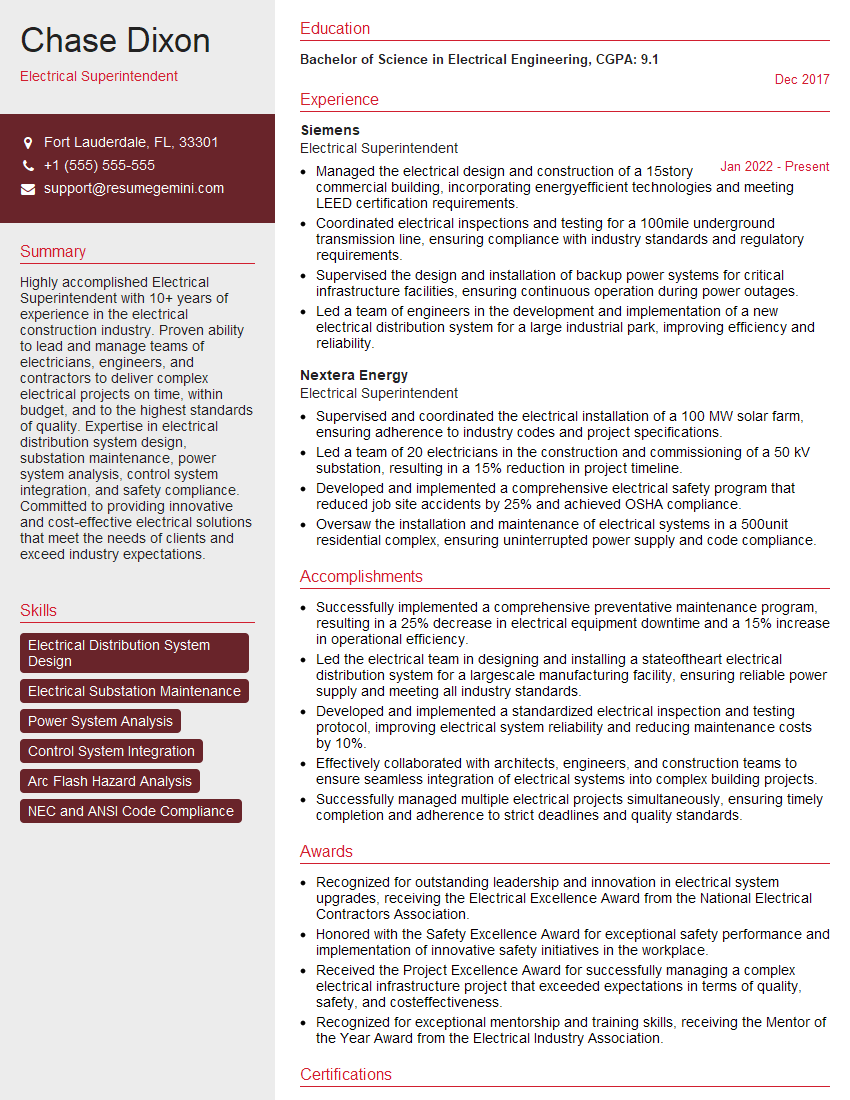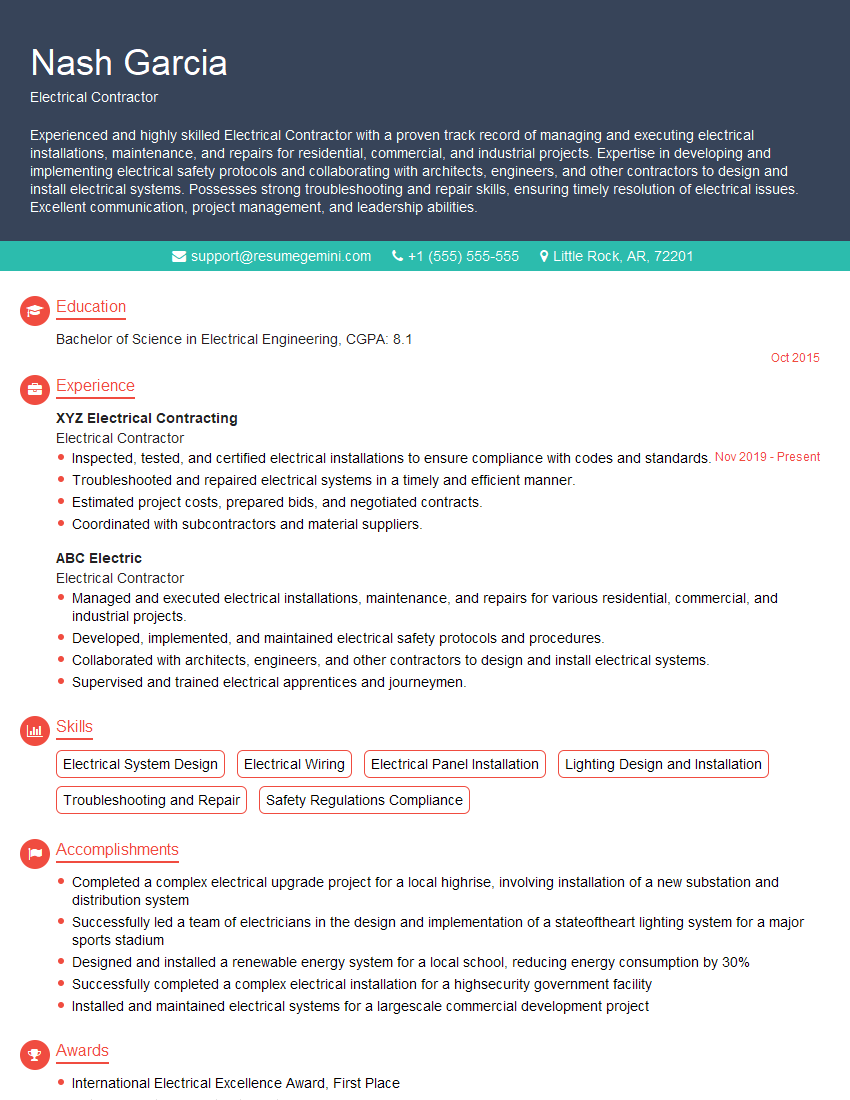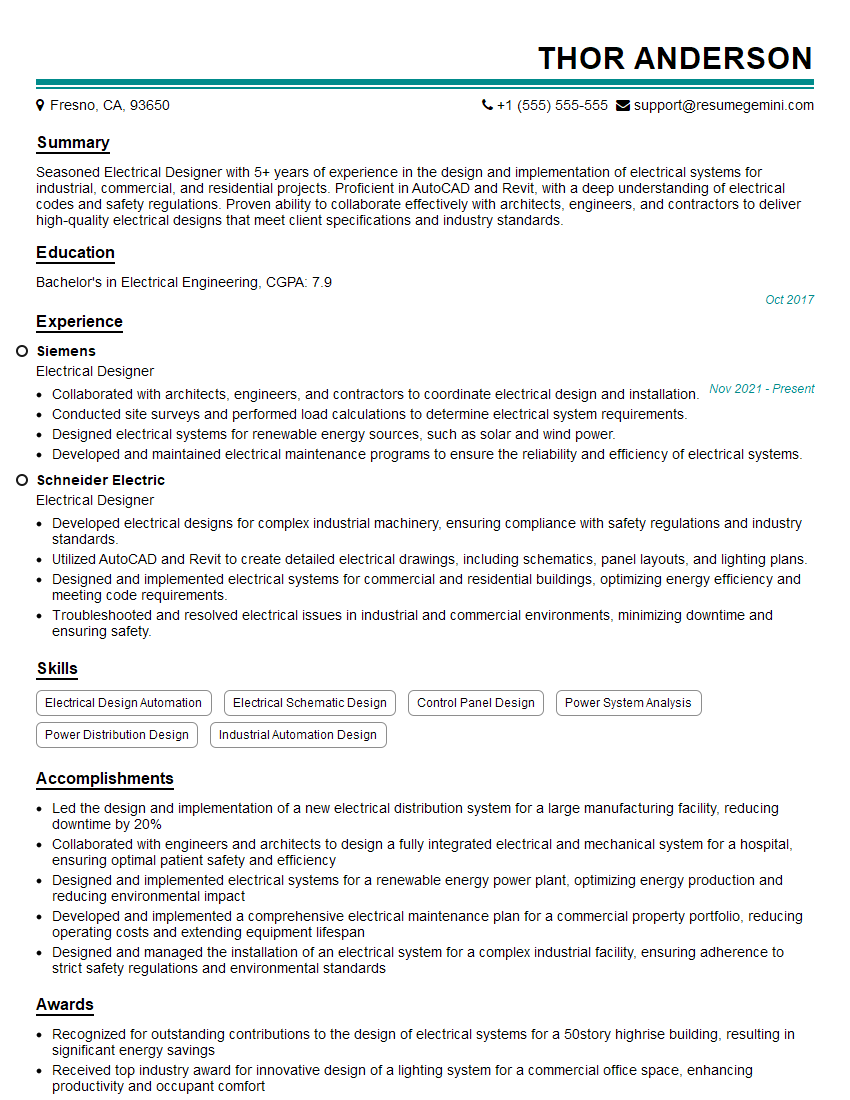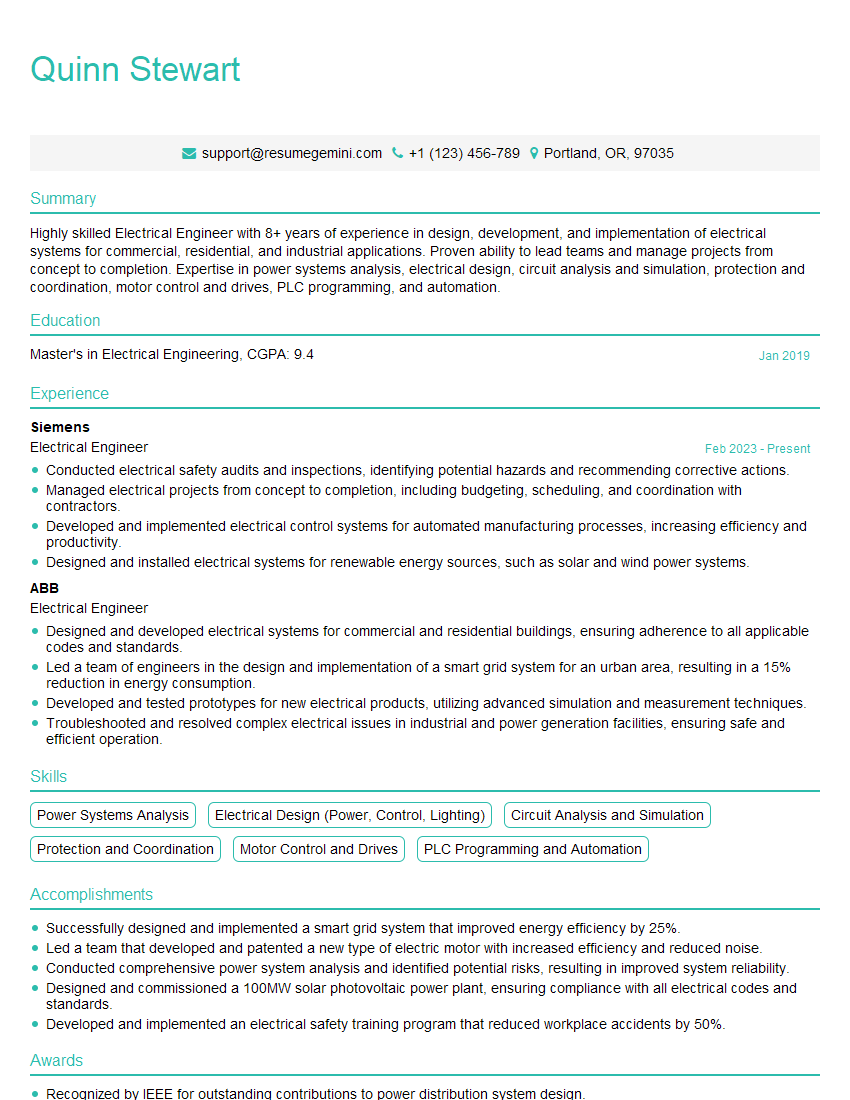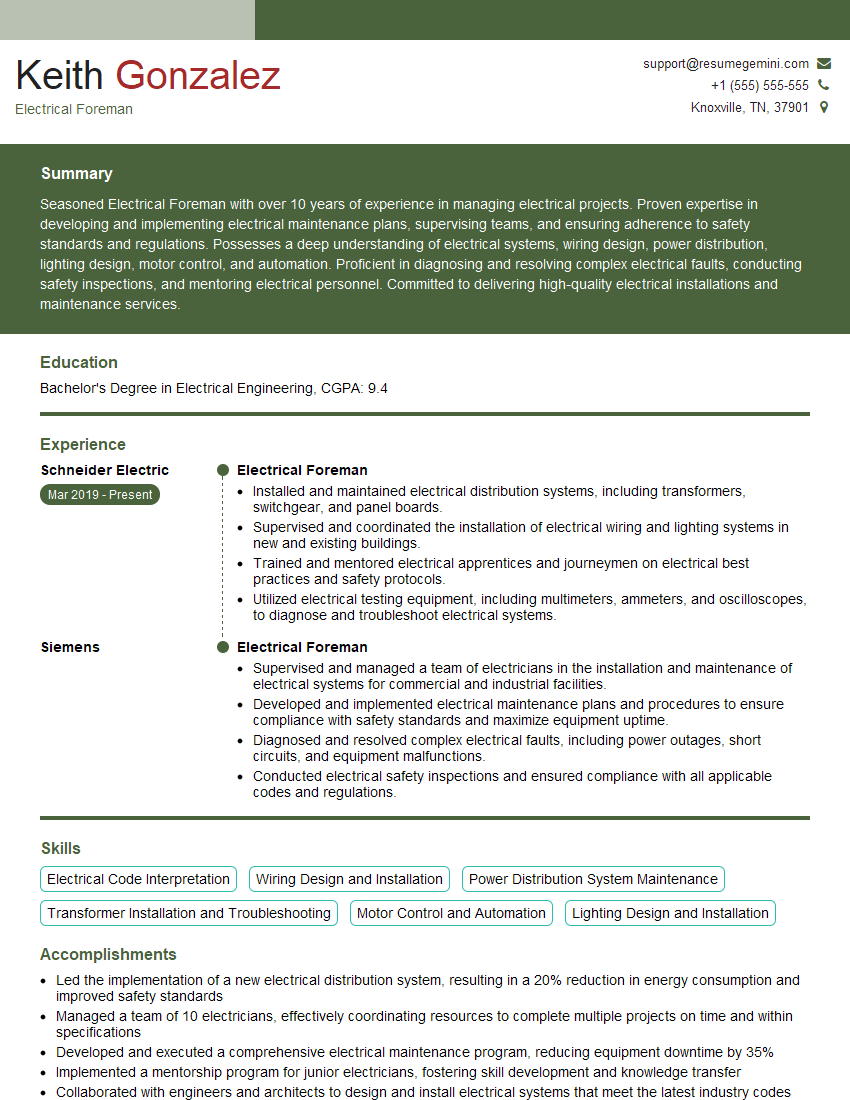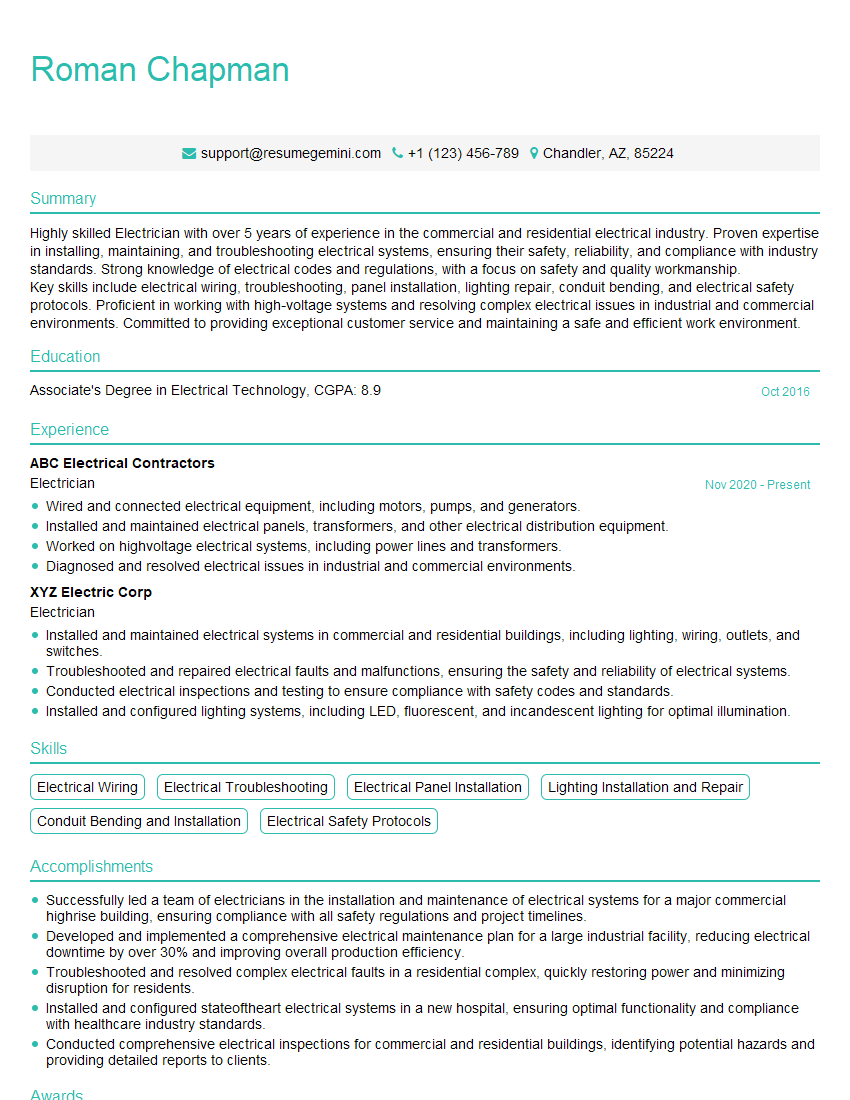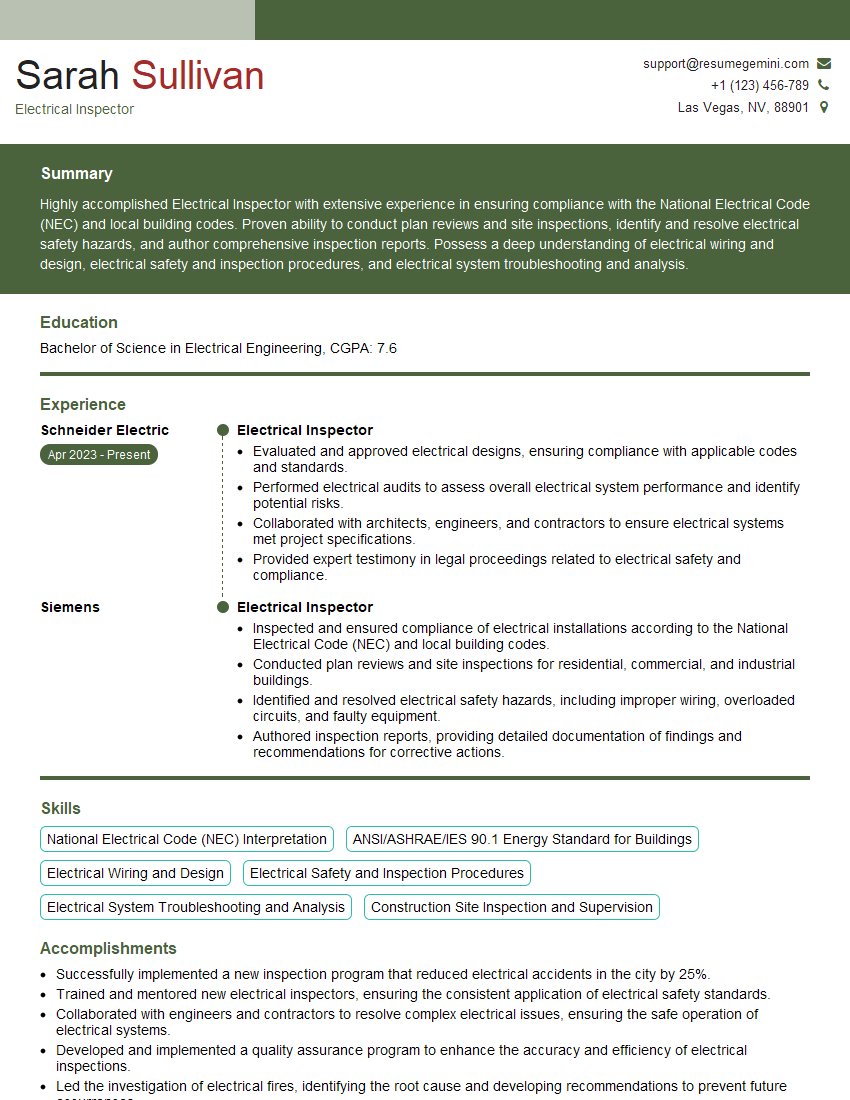Preparation is the key to success in any interview. In this post, we’ll explore crucial National Electrical Code interview questions and equip you with strategies to craft impactful answers. Whether you’re a beginner or a pro, these tips will elevate your preparation.
Questions Asked in National Electrical Code Interview
Q 1. Explain the difference between grounding and bonding.
Grounding and bonding, while both crucial for electrical safety, serve distinct purposes. Think of grounding as a safety net, while bonding is like connecting the links in a chain.
Grounding connects non-current-carrying metal parts of an electrical system to the earth. This provides a path for fault currents to flow safely to the ground, preventing dangerous voltage buildup on exposed metal surfaces. Imagine a lightning strike hitting a metal electrical box – grounding safely diverts that enormous current into the earth, preventing electrocution.
Bonding connects multiple non-current-carrying metal parts within an electrical system to each other. This ensures that these parts are at the same electrical potential, eliminating the possibility of a voltage difference between them that could cause a shock. Think of bonding as equalizing the electrical potential across various metal components to prevent dangerous voltage differences.
In essence: Grounding connects to the earth; bonding connects to each other. Both are required for a safe electrical installation, and they often work together. For example, the grounding electrode conductor connects the grounding electrode to the main bonding jumper which then bonds the neutral and ground conductors at the service equipment.
Q 2. What are the requirements for installing GFCI receptacles?
GFCI (Ground Fault Circuit Interrupter) receptacles are mandated by the NEC in specific locations to protect people from electric shock. They detect imbalances in current flow between the hot and neutral conductors, indicating a potential ground fault. If a fault is detected, the GFCI rapidly interrupts the power, preventing serious injury or even death.
- Bathrooms: GFCIs are required in all bathrooms.
- Garages: Required in garages.
- Outdoor Receptacles: Essential for all outdoor receptacles.
- Kitchens: GFCI protection is required for countertops and sink areas.
- Crawl Spaces and Basements: Usually required.
- Laundry Areas: Receptacles within laundry areas should have GFCI protection.
Other locations may also require GFCI protection based on specific conditions, such as dampness or proximity to water sources. Remember always to consult the latest NEC for the most up-to-date regulations.
Q 3. Describe the NEC requirements for arc-fault circuit interrupters (AFCIs).
AFCIs (Arc-Fault Circuit Interrupters) are designed to protect against electrical fires caused by arcing faults. These faults can occur in branch circuits and are often difficult to detect without specialized protection. AFCIs work by monitoring the electrical waveform for characteristic patterns indicative of arcing. If an arc fault is detected, the AFCI quickly interrupts the circuit to prevent a fire.
The NEC requires AFCIs in specific locations, primarily bedrooms and hallways. The exact requirements can vary depending on the year of the code and the specific circumstances of the installation. Always consult the latest NEC for definitive requirements for your area and project.
It’s important to note that AFCIs are not a replacement for GFCIs. They address different types of electrical hazards. GFCIs protect against shock, while AFCIs protect against fire.
Q 4. What are the rules for calculating voltage drop?
Calculating voltage drop is crucial to ensure that sufficient voltage reaches the load. Excessive voltage drop results in poor performance of equipment and can even cause damage. The formula for voltage drop is:
Voltage Drop = 2 x K x I x L / A
Where:
Kis the resistance constant of the conductor material (e.g., copper or aluminum).Iis the current (in amperes).Lis the length of the conductor (one way distance, in feet).Ais the cross-sectional area of the conductor (in circular mils).
To perform the calculation, you’ll need to know the expected current draw of the load, the length of the circuit run, and the type of conductor being used. NEC tables provide the resistance constants for various conductors.
A significant voltage drop could mean you need to use a larger size conductor, possibly increase the circuit voltage, or reroute the wiring to minimize distance. An example would be a long run to a remote workshop. Calculating and mitigating voltage drop would ensure the equipment in the workshop functions correctly.
Q 5. How do you determine the appropriate size of conductors for a given load?
Determining the appropriate conductor size involves several steps. The primary consideration is the load’s current demand. The NEC provides tables that list ampacities (the current-carrying capacity) of different conductor sizes under various conditions (ambient temperature, installation methods, etc.).
Steps:
- Calculate the total load: Sum the current demands of all loads on the circuit.
- Apply appropriate demand factors: The NEC allows demand factors for certain types of loads (e.g., lighting, appliances). This reduces the total calculated load, recognizing that not all loads will operate at full capacity simultaneously.
- Select a conductor size: Consult NEC tables to find a conductor with an ampacity that exceeds the calculated load. Ensure you also consider any voltage drop calculations.
- Consider environmental factors: Adjust the ampacity rating if the installation is in a high-temperature environment or involves special installation methods (e.g., conduit fill).
For instance, if you are installing a circuit with several lights and receptacles and your load calculation results in a demand of 15 amps, you would choose a conductor with an ampacity of at least 20 amps (this also factors in future potential load increase). This margin of safety helps prevent overheating and potential failures.
Q 6. Explain the NEC requirements for branch circuits.
Branch circuits are the final segments of wiring that supply current to individual outlets, lighting fixtures, and appliances. The NEC specifies many requirements for branch circuits, ensuring safety and proper functionality.
- Ampacity: Branch circuits must be sized to carry the load without exceeding their ampacity.
- Overcurrent Protection: Each branch circuit must be protected by a fuse or circuit breaker rated appropriately for the conductor size and load.
- Number of Outlets: The NEC limits the number of outlets per branch circuit, depending on the circuit’s ampacity.
- Wiring Methods: Specific wiring methods are required depending on the location and environment (e.g., conduit, cable).
- Grounding: Branch circuits must be properly grounded to ensure safety.
Understanding branch circuit requirements is vital for a safe and compliant installation. For example, exceeding the number of outlets per circuit can lead to overloading, possibly resulting in a fire. Each installation should be carefully planned based on the NEC.
Q 7. What are the requirements for installing wiring in wet locations?
Installing wiring in wet locations demands extra precautions to prevent electrical shock and equipment damage. The NEC specifies that only wiring types suitable for wet locations should be used. These types typically have enhanced insulation and sealing to withstand moisture.
- Wiring Types: Use only wiring specifically listed for wet locations in the NEC, such as Type UF (underground feeder) cable or Type THWN (thermoplastic high heat-resistant, nylon-coated) wire within a suitable conduit.
- Conduit and Boxes: Use watertight conduits and boxes to protect the wiring from moisture ingress. Seals are essential.
- Grounding: Proper grounding is crucial in wet locations to ensure a safe path for fault currents.
- Splices and Connections: All splices and connections must be made using appropriate methods and materials to ensure water tightness and prevent corrosion.
Failing to use appropriate materials in wet locations could result in short circuits, electrical shock, and equipment damage. Imagine installing standard wiring in a sprinkler system area; failure would lead to immediate risks. Always prioritize safety and follow the NEC for wet location installations.
Q 8. Describe the NEC rules regarding overcurrent protection.
Overcurrent protection in the NEC is paramount for safety, preventing fires and equipment damage from excessive current. It’s all about ensuring that the current flowing through a circuit never exceeds the capacity of the wiring and equipment. This is achieved through various devices, primarily fuses and circuit breakers.
- Fuses: These are one-time use devices; once the rated current is exceeded, the fuse melts, opening the circuit. They are simple and inexpensive but require replacement after they blow.
- Circuit Breakers: These are reusable devices that automatically interrupt the circuit when the current exceeds a predetermined threshold. They can be thermal (responding to heat generated by excessive current) or magnetic (responding to the magnetic field produced by high current).
The NEC dictates that every circuit must be protected by a fuse or circuit breaker with a rating not exceeding the ampacity of the conductors. For example, a 15-amp circuit must be protected by a 15-amp fuse or circuit breaker, not a 20-amp one. Improper overcurrent protection can lead to overheating, potentially causing fires. The correct size and type of overcurrent protection device are crucial for safety and compliance.
Q 9. What are the requirements for installing lighting fixtures in various locations?
Lighting fixture installation requirements vary significantly depending on location. The NEC outlines specific rules for damp, wet, or hazardous locations to prevent electrical shock and fire hazards.
- Dry Locations: Standard fixtures are suitable. However, proper mounting and wiring techniques are still critical.
- Damp Locations: These areas, like bathrooms or garages without direct exposure to water spray, require fixtures marked for damp locations. They need to withstand higher humidity levels.
- Wet Locations: These are areas exposed to water spray, such as exterior locations near sprinklers or shower areas. Fixtures must be specifically rated for wet locations, typically with weatherproof seals and enclosures.
- Hazardous Locations (Classified Locations): These locations, such as those with flammable vapors or dust, demand explosion-proof or intrinsically safe fixtures designed to prevent ignition. The classification of the hazardous location (Class I, II, or III, and Division 1 or 2) dictates the specific fixture requirements.
Failure to select and install appropriate lighting fixtures for their designated location can result in electrical shock, fire, or other serious hazards. Always consult the NEC and manufacturer’s instructions for specific requirements.
Q 10. Explain the NEC requirements for service equipment.
Service equipment, the point where the utility power enters a building, needs to meet rigorous NEC standards for safety and reliability. This includes the main disconnect, metering equipment, and overcurrent protection for the entire service.
- Main Disconnect: Must be readily accessible and clearly labeled. It allows the complete disconnection of power to the building for safety purposes.
- Overcurrent Protection: Service entrance conductors must be protected by an appropriately sized main breaker or fuses. The size depends on the calculated load and the ampacity of the service conductors.
- Metering Equipment: Usually provided by the utility company, it measures the electricity consumed. Proper installation and access are critical.
- Grounding: The service equipment must be properly grounded to provide a path for fault currents to earth, protecting against electrical shocks.
- Enclosures: Must be suitable for the environment, offering protection from the elements and providing safe access.
A properly installed and maintained service equipment is crucial for the safety and reliability of the entire electrical system. Improper installation can lead to significant hazards.
Q 11. How do you calculate the demand load for a residential service?
Calculating the demand load for a residential service involves determining the total amount of power the home is expected to use simultaneously. The NEC provides methods to simplify this process, avoiding the need to analyze every appliance’s usage at once. The most common method utilizes demand factors, which account for the fact that not all appliances run at the same time.
A simplified approach is to sum up the load of all general-purpose circuits (lighting, receptacles, etc.) using Table 220.14 of the NEC, then add the loads of other appliances (such as air conditioning, heating, etc.) at their full rated wattage. Specific calculations can become more complex depending on the details of the electrical system, involving considerations like the number of circuits, type of appliances, and any special equipment.
Example: A home with 10 general-purpose circuits would have a base load of 10 x 1500VA (typical receptacle circuit value) = 15000VA (or 15kVA). Adding a 5000VA air conditioning unit would raise the total to 20000VA. This value then forms the basis for selecting the appropriate service size. Remember to consult the current NEC for the most accurate and up-to-date calculation methods.
Q 12. What are the requirements for grounding electrical systems?
Grounding electrical systems is crucial for safety. It provides a low-impedance path for fault currents to earth, preventing dangerous voltages from appearing on exposed conductive surfaces and minimizing the risk of electrical shock. The NEC mandates several grounding requirements, including grounding the service equipment, grounding the building’s structure, and grounding all electrical equipment.
- Grounding Electrode System: A network of conductors connecting the electrical system to the earth, usually through a ground rod or other suitable electrode. This provides the path to earth for fault currents.
- Equipment Grounding Conductor: A wire connecting metallic parts of equipment and enclosures to the grounding electrode system. This protects against electrical shocks should a fault occur.
- Grounding of Service Equipment: The service panel must be effectively grounded to prevent dangerous voltages. This connection is usually made by a ground rod or other appropriate electrode.
- Grounding of Metal Conduit and Boxes: Metallic conduits and boxes must be bonded together to form a continuous grounding path. This ensures that any faults are safely channeled to earth.
A properly grounded electrical system is fundamental for electrical safety. Without proper grounding, a fault could result in lethal voltages on exposed metal surfaces. A competent electrician is crucial for ensuring correct grounding.
Q 13. What are the NEC requirements for working on energized equipment?
Working on energized equipment is extremely dangerous and should only be undertaken by qualified and trained personnel. The NEC emphasizes the importance of safety procedures and requires specific precautions to mitigate the risk of electrical shock and arc flash hazards. Working on energized equipment without proper safety measures is strictly prohibited and can result in serious injury or death.
- Lockout/Tagout Procedures: Always disconnect and de-energize the equipment before performing any work, using appropriate lockout/tagout procedures to prevent accidental energization.
- Arc Flash Hazard Analysis: For higher voltage equipment, a detailed arc flash hazard analysis must be performed to determine the appropriate personal protective equipment (PPE) required.
- Personal Protective Equipment (PPE): Appropriate PPE, including insulated tools, gloves, and protective clothing, is mandatory when working on or near energized equipment.
- Qualified Personnel: Only qualified and trained personnel familiar with the hazards involved should work on energized equipment.
Never compromise safety when working on electricity. Following NEC guidelines and using appropriate safety procedures is crucial to prevent accidents.
Q 14. Explain the difference between a Type B and Type MC cable.
Type B and Type MC cables are both used for electrical wiring, but they differ significantly in their construction and applications.
- Type B (BX) Cable: This is a flexible armored cable consisting of insulated conductors encased in a flexible metal sheath. The sheath provides mechanical protection and grounding. However, Type B is often more difficult to work with compared to other cable types, its use is being increasingly replaced by other options such as MC cable.
- Type MC Cable (Metal-Clad Cable): This is another armored cable with conductors enclosed within a corrugated metallic sheath. It also offers mechanical protection and grounding. It often includes a separate grounding conductor for improved safety. It is generally easier to install than Type B.
The key difference lies in the construction of the sheath. Type MC offers superior protection and is easier to install, making it a more popular choice for many applications, though Type B may still be encountered in older installations. The appropriate cable type must be selected based on the NEC requirements for the specific installation conditions, such as the environment (wet, damp, etc.) and the location.
Q 15. Describe the NEC requirements for installing raceways.
The NEC outlines stringent requirements for raceway installation to ensure safety and code compliance. Raceways, which are enclosures for electrical conductors, must be properly sized, supported, and protected. This involves several key considerations:
- Proper Sizing: Raceways must be large enough to accommodate the number and size of conductors they contain, with sufficient space for efficient heat dissipation. Overfilling a raceway can lead to overheating and potential fire hazards. For example, if you’re installing multiple 12 AWG wires, you’ll need to consult NEC Table 314.16(A) to determine the minimum raceway size.
- Secure Support: Raceways need secure and regular support to prevent sagging, damage, and potential hazards. The spacing between supports depends on the type of raceway and its size. Think of it like building a sturdy bridge – proper support is essential for preventing collapse. The NEC specifies maximum spans between supports, preventing sagging and accidental damage.
- Protection from Damage: Raceways must be protected from physical damage, such as being run through areas where they could be crushed or punctured. In areas prone to impact, they need extra protection, possibly through conduit with additional shielding. Imagine placing a delicate cable exposed to construction equipment – it’s a recipe for disaster.
- Correct Bends: Bends in the raceway must be made carefully to avoid damaging the conductors and ensure a smooth flow of wires. Excessive bends can restrict the flow of air, leading to overheating. The NEC specifies minimum bending radii for different types of raceways.
- Proper Grounding: Metallic raceways must be properly grounded to protect against electrical shock. This is a critical safety feature; grounding helps provide a path for fault current, protecting personnel.
Failure to adhere to these requirements can result in significant safety hazards, including electrical fires, shocks, and equipment damage. Always consult the latest edition of the NEC and relevant local codes for the most accurate and up-to-date information.
Career Expert Tips:
- Ace those interviews! Prepare effectively by reviewing the Top 50 Most Common Interview Questions on ResumeGemini.
- Navigate your job search with confidence! Explore a wide range of Career Tips on ResumeGemini. Learn about common challenges and recommendations to overcome them.
- Craft the perfect resume! Master the Art of Resume Writing with ResumeGemini’s guide. Showcase your unique qualifications and achievements effectively.
- Don’t miss out on holiday savings! Build your dream resume with ResumeGemini’s ATS optimized templates.
Q 16. What are the requirements for installing smoke alarms?
The NEC mandates the installation of smoke alarms to protect lives and property. Key requirements include:
- Location: Smoke alarms must be installed inside each bedroom, outside each sleeping area, and on every level of a dwelling, including the basement. Think of it as a comprehensive network providing early warning throughout the house.
- Spacing: Alarms should be interconnected so that when one detects smoke, all alarms sound. This ensures that everyone in the home is alerted simultaneously.
- Type: Ionization or photoelectric smoke alarms, or a combination, are acceptable. Ionization detectors respond faster to flaming fires, while photoelectric detectors are often more sensitive to smoldering fires.
- Testing and Maintenance: Smoke alarms must be tested monthly to ensure they are functioning correctly. Batteries should be replaced as needed, typically once a year. This regular maintenance is vital to maintain effectiveness.
- Placement Height: Alarms should be mounted high on walls or ceilings, typically at least 12 inches away from the ceiling.
Many jurisdictions have stricter requirements, often mandating hardwired, interconnected alarms with battery backup. Ignoring these requirements could have fatal consequences in case of a fire.
Q 17. Explain the NEC requirements for emergency lighting.
The NEC addresses emergency lighting requirements to ensure safe evacuation during power outages. Key aspects include:
- Power Source: Emergency lighting systems must have a reliable backup power source, typically batteries, to function during power failures. Think of it as an independent life-saving system.
- Illumination Levels: The NEC specifies minimum illumination levels for exit routes and other areas requiring emergency lighting. This ensures sufficient visibility for safe evacuation in low-light conditions.
- Duration: Emergency lighting must operate for a minimum duration (typically 90 minutes) after a power failure. This time provides ample opportunity for evacuation.
- Testing: Regular testing is required to verify the functionality and proper operation of the emergency lighting system, usually monthly and annually, with documentation.
- Exit Markings: Emergency lighting often includes exit signs directing people to the nearest safe exits.
The specific requirements vary depending on the occupancy type and size of the building. It’s crucial to adhere to local codes and NEC guidelines for proper design, installation, and maintenance to prevent a situation where emergency lighting is needed but fails.
Q 18. What are the NEC requirements for working in confined spaces?
Working in confined spaces presents unique electrical hazards, necessitating careful adherence to safety regulations. The NEC doesn’t directly address confined space entry, but its requirements indirectly impact safety in these situations. Key precautions include:
- Permit-Required Confined Space Entry: Before entering a confined space, a permit-required confined space entry program must be in place, including atmospheric testing for hazardous gases and oxygen levels. Think of this as a mandatory checklist to ensure safety.
- Lockout/Tagout Procedures: Before any electrical work is performed, a lockout/tagout procedure must be implemented to de-energize and isolate the equipment. This prevents accidental energization during maintenance or repair.
- Ventilation: Adequate ventilation is crucial to prevent the buildup of hazardous gases or lack of oxygen, especially in enclosed spaces. Ventilation prevents potential asphyxiation hazards.
- Specialized Lighting: Appropriate lighting and tools should be used to ensure visibility within the confined space. Poor lighting can increase the risk of accidents.
- Trained Personnel: Only qualified and trained personnel should enter and work in confined spaces. Proper training is paramount for awareness of hazards and safe work practices.
- Ground Fault Circuit Interrupters (GFCIs): GFCIs must be used to protect workers from electrical shocks, especially in damp or wet environments commonly found in confined spaces.
Failing to follow these precautions could lead to serious injury or fatality. Always prioritize safety and consult appropriate OSHA guidelines in addition to NEC requirements when working in confined spaces.
Q 19. How do you identify and address electrical hazards on a jobsite?
Identifying and addressing electrical hazards on a jobsite is paramount for safety. A systematic approach is crucial:
- Visual Inspection: Begin with a thorough visual inspection of the entire jobsite, looking for damaged wiring, exposed conductors, overloaded circuits, faulty equipment, and other potential hazards. Think of it like a detective’s methodical search for clues.
- Testing and Measurement: Use appropriate testing equipment such as multimeters and insulation testers to verify the integrity of electrical systems. This verifies what you see visually.
- Lockout/Tagout Procedures: Implement lockout/tagout procedures before performing any electrical work to prevent accidental energization. This prevents accidental contact with live circuits.
- Grounding and Bonding: Ensure proper grounding and bonding of equipment to prevent electrical shocks. This ensures the safety of personnel.
- Personal Protective Equipment (PPE): Workers must wear appropriate PPE, including insulated gloves, eye protection, and safety footwear. Appropriate PPE minimizes risk of injury.
- Emergency Response Plan: Develop and communicate an emergency response plan to deal with electrical accidents or emergencies. This establishes a protocol in case of an incident.
- Documentation: Maintain detailed records of inspections, testing, and corrective actions. This serves as evidence of compliance and a historical record.
Proactive hazard identification and mitigation are far more effective than reactive measures. Ignoring electrical hazards can result in severe injury, death, or property damage.
Q 20. Describe the NEC requirements for using flexible cords and cables.
The NEC regulates the use of flexible cords and cables to ensure safety. These are not intended as a permanent wiring method but for specific applications:
- Limited Use: Flexible cords and cables are for temporary wiring or connecting portable equipment. They are not suitable for permanent installations where they might be subjected to damage or excessive heat. Think of them as temporary, not permanent wiring solutions.
- Proper Support: Flexible cords and cables must be protected from damage and appropriately supported to prevent strain and breakage. This reduces the risk of short circuits or damage to the cord.
- Overcurrent Protection: Flexible cords and cables must be protected by overcurrent protection devices (e.g., fuses or circuit breakers) sized according to the cord’s ampacity. This prevents overheating and potential fires.
- Appropriate Type: The type of flexible cord or cable used must be appropriate for the intended application, environmental conditions, and voltage. Using the wrong type of cord can be disastrous.
- Ampacity Rating: Never exceed the ampacity rating of the cord or cable. Overloading a cord can lead to overheating and fire.
Improper use of flexible cords and cables is a frequent cause of electrical fires. Always choose the correct type, size, and rating for the application and follow the NEC guidelines carefully.
Q 21. What are the requirements for installing receptacles in garages?
Garages present unique electrical hazards, hence specific NEC requirements for receptacle installation:
- GFCI Protection: All 125-volt, single-phase, 15- and 20-ampere receptacles in garages must be GFCI protected. This protects against electrical shocks, especially in damp conditions.
- Receptacle Height: Receptacles should be installed at a convenient height for use, typically between 12 inches and 18 inches above the floor. This ensures easy access and usability.
- Dedicated Circuits: Heavy-duty appliances should be served by dedicated circuits to avoid overloading the receptacle and its wiring. This prevents overcurrent hazards.
- Location: Receptacles should be located to easily reach areas where tools and equipment are typically used. This enhances safety and usability.
- Weather Protection: Exterior receptacles should be weatherproofed to prevent water intrusion. This protects against electrical shocks and short circuits.
Failure to meet these requirements increases the risk of electrical shock and fire. Adhering to these standards is essential for safety and compliance.
Q 22. Explain the difference between a single-pole and double-pole breaker.
The key difference between single-pole and double-pole breakers lies in the number of hot wires they control. A single-pole breaker controls one hot wire, typically used in 120-volt circuits powering standard household outlets and lighting. Think of it like a single light switch controlling one light. A double-pole breaker controls two hot wires, commonly found in 240-volt circuits powering appliances like ovens, dryers, and air conditioners. It’s like having two light switches linked together, turning two lights on or off simultaneously. This is crucial for safety; a double-pole breaker provides a complete disconnect from both hot wires of a 240-volt circuit, ensuring a safer shutdown.
For example, a single-pole breaker might be used for a typical bedroom lighting circuit, while a double-pole breaker would be necessary for a 240-volt electric range circuit. The choice of breaker depends entirely on the voltage of the circuit being protected.
Q 23. What are the NEC requirements for installing outdoor lighting?
NEC requirements for outdoor lighting focus heavily on safety and protection from the elements. Article 410 covers lighting fixtures and their installation. Key considerations include:
- Fixture Type: Fixtures must be specifically listed for outdoor use, signifying their weather resistance and suitability for damp or wet locations (e.g., marked as ‘wet location’ or ‘damp location’).
- Wiring Methods: Outdoor wiring must use appropriate cable types, such as UF (Underground Feeder) cable, to withstand moisture and direct burial. The cable should also be properly secured and protected from physical damage.
- Grounding: Proper grounding is critical for safety to prevent electric shock. All metal parts of the fixture and its associated wiring must be grounded effectively.
- GFCI Protection: Ground Fault Circuit Interrupters (GFCIs) are often required for outdoor lighting circuits, especially near water sources, to minimize the risk of electric shock. This helps prevent injury from ground faults that might otherwise go undetected.
- Clearances: Minimum clearances must be maintained between lighting fixtures and other objects, especially flammable materials, to prevent fire hazards. These clearances are detailed in Article 410 of the NEC.
Ignoring these requirements could lead to electrical hazards, damage to equipment, and potential personal injury.
Q 24. Describe the NEC requirements for working with transformers.
The NEC addresses transformer installation in Article 450. Key requirements emphasize safety and proper operation:
- Clearances: Transformers must have sufficient clearances from combustible materials to prevent fire. These clearances vary based on the transformer’s size and type.
- Overcurrent Protection: Transformers must have appropriate overcurrent protection devices (fuses or circuit breakers) to prevent overheating and potential fire hazards.
- Grounding: Transformers must be grounded to prevent electric shock hazards. The grounding methods vary depending on the transformer’s type and installation location.
- Marking and Identification: Transformers should be properly marked with their voltage, current, and other relevant specifications for easy identification and safety.
- Installation Location: Transformers should be installed in suitable locations to ensure proper ventilation and protection from the elements. This often involves secure mounting and potentially enclosures to protect against physical damage.
Failing to adhere to these requirements could lead to equipment failure, fire hazards, and serious injury.
Q 25. Explain the NEC requirements for installing motor circuits.
NEC Article 430 specifically outlines requirements for motor circuits. Key elements include:
- Overload Protection: Motors must have overload protection to prevent overheating and damage. This is typically achieved using thermal protectors built into the motor or external overload relays.
- Short-Circuit and Ground-Fault Protection: Circuit breakers or fuses are required to protect the motor circuit from short circuits and ground faults.
- Conductor Sizing: Conductors must be sized to handle the motor’s full-load current and starting current. Calculations using NEC tables are necessary to determine the appropriate conductor size.
- Disconnecting Means: A readily accessible disconnecting means (switch or circuit breaker) must be provided to disconnect the motor from the power source for maintenance or emergencies.
- Motor Control Circuits: Control circuits, such as those for motor starters, must meet specific requirements for safety and reliability.
Improper installation of motor circuits can lead to motor burnout, equipment damage, and potential fire hazards.
For example, neglecting to size the conductors appropriately for the motor’s starting current could result in voltage drops and motor failure. Similarly, a lack of overload protection can lead to overheating and motor damage.
Q 26. What are the NEC requirements for working with solar photovoltaic systems?
The NEC, specifically Article 690, addresses the installation of solar photovoltaic (PV) systems. Key areas of focus include:
- System Grounding: The entire PV system must be effectively grounded to prevent electric shock hazards. Grounding is typically achieved using grounding rods and bonding conductors.
- Overcurrent Protection: Appropriate overcurrent protection devices (circuit breakers or fuses) are necessary to protect the PV system from overcurrents and faults.
- Wiring Methods: PV system wiring must be installed using methods suitable for outdoor use, considering the potential for exposure to sunlight, moisture, and temperature extremes.
- Rapid Shutdown: Rapid shutdown systems are often required to allow firefighters and emergency personnel to safely approach and work on the system.
- Arc Flash Mitigation: Methods to reduce arc flash hazards during maintenance or troubleshooting are often required, especially in larger systems.
The specific requirements for a PV system will depend on the system’s size, voltage, and location. Consult Article 690 in the NEC for detailed specifications and requirements.
Q 27. How do you interpret NEC tables and calculations?
Interpreting NEC tables and calculations requires careful attention to detail and a good understanding of electrical principles. NEC tables provide data for various electrical parameters, such as wire ampacity, voltage drop, and conduit fill. These tables are essential for proper design and installation.
Here’s a general approach:
- Identify the Relevant Table: Determine which table contains the information needed. This requires understanding the specific electrical parameters involved (e.g., conductor ampacity, conduit fill, etc.).
- Understand Table Parameters: Pay close attention to the table’s headings and column descriptions. Understand the units of measurement (amps, volts, etc.) and any qualifying notes or conditions.
- Locate the Appropriate Data: Use the table’s parameters to identify the relevant row and column containing the desired information. For instance, finding the ampacity of a specific wire size at a particular temperature would involve locating the wire’s size and its corresponding ampacity at the specified temperature.
- Apply Necessary Corrections: Some tables require adjustments based on certain factors (e.g., ambient temperature, number of conductors in a conduit). These correction factors are usually explained in the table’s footnotes or accompanying text.
- Perform Calculations: Some calculations might be required to determine an appropriate value. For example, determining the voltage drop in a circuit requires calculating the resistance of the conductors and then applying Ohm’s Law.
Accurate interpretation of NEC tables and calculations is crucial for ensuring electrical systems comply with safety standards and perform reliably.
For instance, when sizing conductors for a motor circuit, you would use tables to determine the appropriate wire size based on the motor’s full-load current and the length of the circuit to ensure it carries the load without overheating or excessive voltage drop. Incorrect interpretation could result in unsafe and unreliable installations.
Key Topics to Learn for National Electrical Code Interview
- Wiring Methods and Materials: Understanding various wiring methods (conduit, cable, etc.), their applications, and material selection based on NEC requirements. This includes practical considerations like voltage drop calculations and ampacity.
- Overcurrent Protection: Mastering the principles of circuit breakers, fuses, and their coordination to ensure safety and compliance. Be prepared to discuss practical scenarios involving fault current calculations and breaker sizing.
- Grounding and Bonding: A thorough understanding of grounding and bonding techniques, their importance in electrical safety, and the relevant NEC articles. This includes practical application in different electrical systems.
- Branch Circuits and Panelboards: Knowledge of branch circuit design, calculations, and panelboard layout according to NEC standards. This includes understanding load calculations and proper circuit protection.
- Motors and Motor Controls: Understanding motor starting methods, overload protection, and motor control circuits as per NEC requirements. Be ready to discuss practical applications and troubleshooting scenarios.
- Special Occupancies: Familiarity with NEC requirements for specific occupancies like healthcare facilities, industrial settings, and hazardous locations. This includes understanding the unique safety considerations involved.
- Code Interpretation and Problem-Solving: Develop your ability to interpret NEC articles and apply them to real-world scenarios. Practice solving problems related to code compliance and troubleshooting electrical systems.
Next Steps
Mastering the National Electrical Code is crucial for career advancement in the electrical field, opening doors to higher-paying roles and increased responsibility. A strong understanding of the NEC demonstrates your commitment to safety and professional competence, making you a highly desirable candidate. To further enhance your job prospects, focus on creating an ATS-friendly resume that effectively highlights your skills and experience. ResumeGemini is a trusted resource to help you build a professional and impactful resume, ensuring your qualifications stand out. Examples of resumes tailored to National Electrical Code expertise are available to help guide you.
Explore more articles
Users Rating of Our Blogs
Share Your Experience
We value your feedback! Please rate our content and share your thoughts (optional).
What Readers Say About Our Blog
This was kind of a unique content I found around the specialized skills. Very helpful questions and good detailed answers.
Very Helpful blog, thank you Interviewgemini team.
